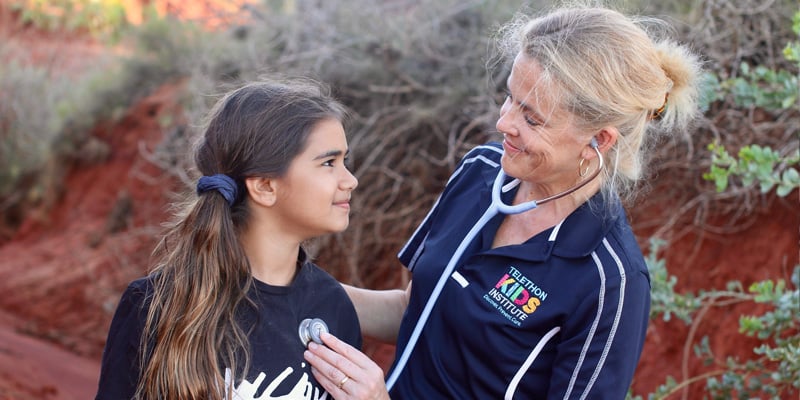
Key points:
- Almost one in five children in four remote Kimberley communities has some form of chronic lung disease
- The findings highlight the urgent need to address life-shortening lung conditions in remote communities
- 43 children who took part in the study are now receiving treatment for conditions they were not previously aware of
- The study’s findings were published in the journal Paediatric Pulmonology
Almost one in five children across four remote Kimberley communities has some form of chronic lung disease, according to a new study co-designed and conducted in partnership with Aboriginal communities.
A team of clinician-researchers from the Wal-yan Respiratory Research Centre – a powerhouse partnership between The Kids Research Institute Australia, Perth Children’s Hospital Foundation and the Perth Children’s Hospital – worked with the Kimberley Aboriginal Medical Service and 16 Aboriginal community researchers to screen almost 400 (92%) children aged 0-18 years living in the four communities.
The results reveal 17.9 per cent of the children screened had a chronic respiratory disease – either protracted bacterial bronchitis (PBB), chronic suppurative lung disease (CSLD), bronchiectasis, or asthma.
PBB and CSLD are conditions which, if not properly treated, can lead to bronchiectasis – a disease that eats away at the lungs, causing progressive, irreversible, and life-shortening damage. The early, and often only, symptom is a wet cough that persists for four or more weeks.
PBB was confirmed in 30 (7.7%) of the children, while CSLD was confirmed in 13 (3.3%) children, bronchiectasis in 5 (1.3%), and asthma in 17 (4.3%).
Lead author, Perth Children’s Hospital (PCH) respiratory physiotherapist and researcher Dr Pam Laird, said the results built substantially on a 2019 study which revealed that one in ten children aged 0-7 years across the four communities had PBB.
“Last time we only looked at PBB, and only in children aged under 7 years,” Dr Laird said.
“While this was real breakthrough information – the first study to examine the prevalence of PBB anywhere in the world – the communities we worked with wanted to know about their older kids, too, and asked us to come back to look at all children.
“So, this time we looked at the whole child population across these four communities and we looked for all chronic lung diseases, rather than just PBB.”
Dr Laird said the findings would help to fill a serious information gap about how common and serious chronic lung disease is in Aboriginal children, and how important it is to tackle it in a culturally secure way.
“The big one is bronchiectasis,” she said. “There’s very little data on the prevalence of that disease in First Nations people across the world, because not many people know it exists or are screening for it – and that’s the one that can seriously limit life expectancy. For Aboriginal people, it can be in their 30s and 40s.
“But it’s also critical that we know about rates of PBB and CSLD because they are steps along the way to bronchiectasis, and if we can identify and treat children early, we can stop it from progressing to severe disease.”
The screening undertaken for the study, which included spirometry and assessments by PCH respiratory physicians, identified three children with bronchiectasis who had not previously been diagnosed, and dozens more children with previously undiagnosed PBB or CSLD – enabling them to commence potentially life-saving treatment.
As a result of this study 43 children are now receiving treatment for conditions they were not previously aware of – that’s 43 pairs of little lungs rescued.
She said the results revealed a high disease burden in Aboriginal children and highlighted the urgent need to address it.
“We’ve done a lot of work over the past few years, in partnership with Aboriginal communities, Aboriginal medical services, the Child and Adolescent Health Service and the WA Country Health Service, to increase awareness of chronic wet cough and the conditions it can lead to, but these findings show there’s much more to be done to ensure children with these lung conditions are identified early and treated effectively,” Dr Laird said.
“So, the work has started and there is exciting progress, but these high numbers just highlight the urgency and show that we can’t stop.
The scary thing is that these conditions can quickly turn into a big problem. We’ve had kids that are very sick, very young with devastating outcomes. It doesn’t have to be that way.
“We need to implement strategies that we know work in Aboriginal contexts to nip this problem in the bud, because the reality is it’s easy to fix if we identify it early enough. But that means resources and knowledge for both communities and clinicians.”
Kimberley mother Belinda Sampi, who worked as a Community Navigator with the research team, said the community hoped the project could prevent bronchiectasis for other children.
“This project coming to our community benefited us by hearing important information about wet cough and the damages it can do to children if not educated enough,” she said.
“I have been living the life experience with my daughter. She is 12 now but was diagnosed with bronchiectasis at the age of 4.
“Continuing to live this life with Kiarna’s condition has impacted us in many ways, like physical, emotional, financial and mentally. Not just for Kiarna, but the extended family.
“So I hope this project can prevent bronchiectasis for other children.”
The paper – Prevalence of chronic respiratory diseases in Aboriginal children: A whole population study – was published in the journal Paediatric Pulmonology and can be read here.
This research was supported by the Medical Research Future Fund and by Mineral Resources Limited, which proudly supports the Wal-yan Respiratory Research Centre as Principal Partner of the BREATH (Building Respiratory Equity for Aboriginal and Torres Strait Islander Health) Team. The team is led by paediatric lung health researcher, and Mineral Resources Fellow, Associate Professor André Schultz.
